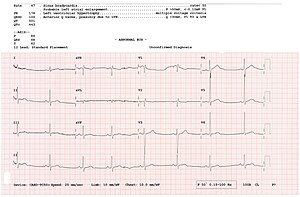Electrocardiogram

An electrocardiogram (ECG or EKG) is a record of the electrical activity of the heart over a period of time.[1] The instrument that makes the record is the ECG machine or Electrocardiograph. Willem Einthoven invented it in 1902.[2] An ECG uses electrodes attached on your chest and limbs on the surface of the skin. It tracks and documents the heart’s electrical activity.[3]
An electrocardiogram monitors the heart. Your own internal pacemaker, your sinoatrial node, starts your heartbeat with an electrical signal. An EKG reads that signal and tracks its impact on your heart as it contracts and relaxes with each heartbeat.[3] Doctors can use an electrocardiogram to look for patterns among these heartbeats and rhythms to diagnose and interpret various heart conditions.
ECG is used to measure the rate and regularity of heartbeats, the size and position of the chambers, the presence of any damage to the heart, and the effects of drugs or devices used to regulate the heart, such as an artificial pacemaker.
An electrocardiogram is a non invasive painless procedure. The results of your electrocardiogram will likely be reported immediately after it is done.
- ↑ Sattar, Yasar; Chhabra, Lovely (2024), "Electrocardiogram", StatPearls, Treasure Island (FL): StatPearls Publishing, PMID 31747210, retrieved 2025-01-07
- ↑ Salam, AmarM (2019). "The invention of electrocardiography machine". Heart Views. 20 (4): 181. doi:10.4103/HEARTVIEWS.HEARTVIEWS_102_19. ISSN 1995-705X.
{{cite journal}}: CS1 maint: unflagged free DOI (link) - ↑ 3.0 3.1 "Electrocardiogram (EKG/ECG)". Cleveland Clinic. Retrieved 2025-01-07.